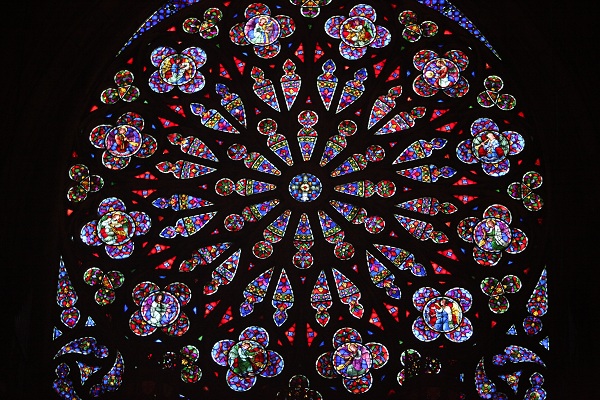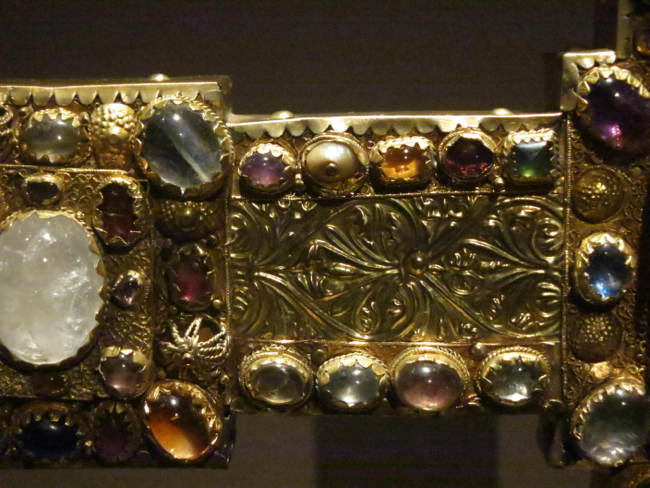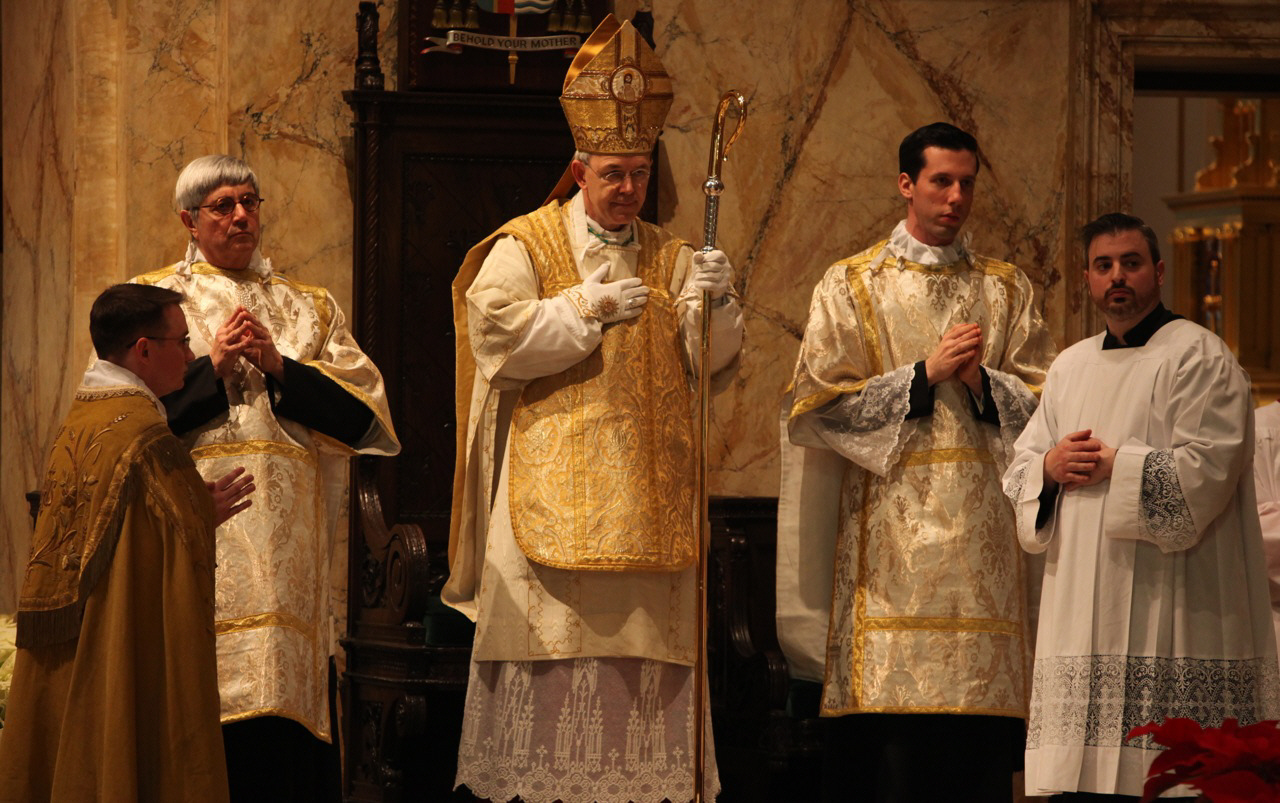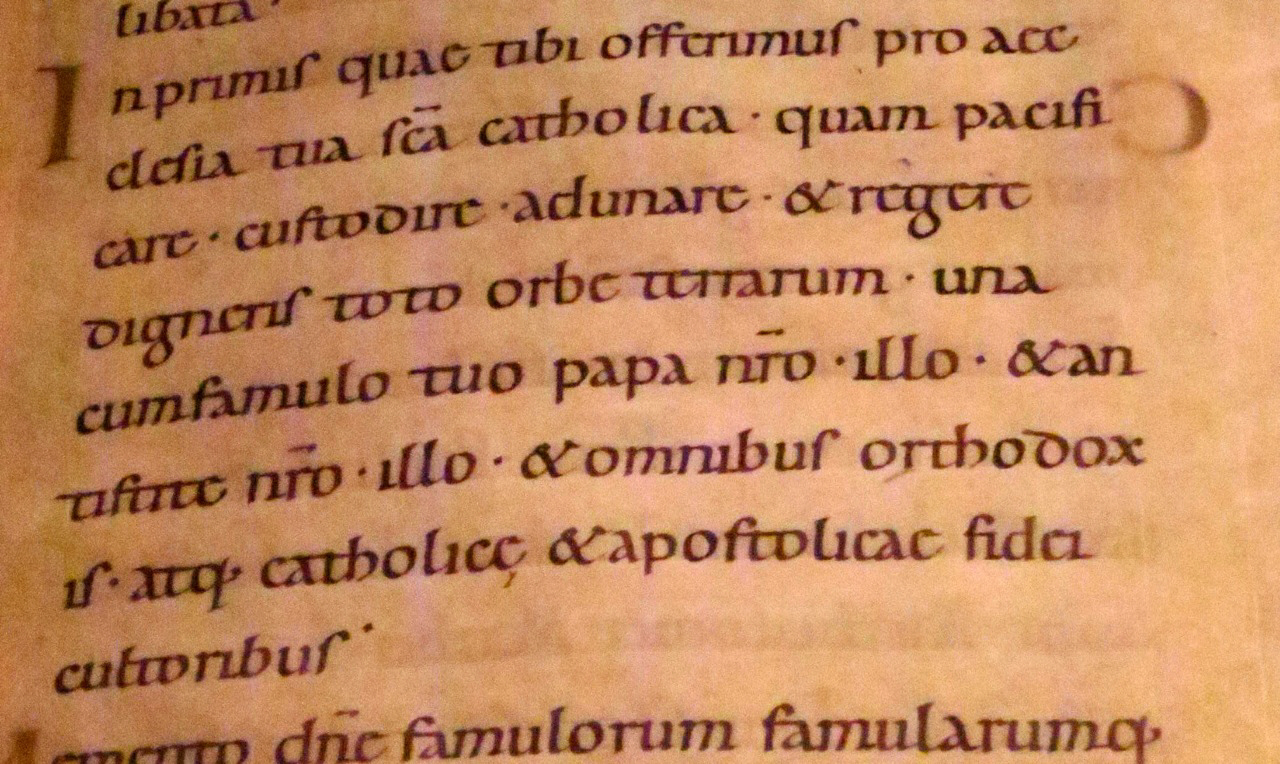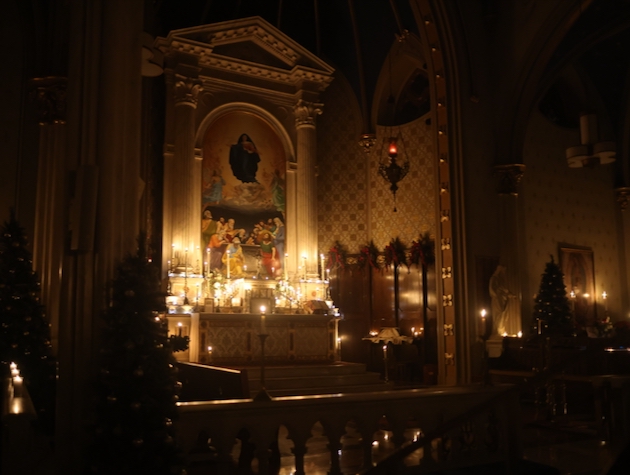
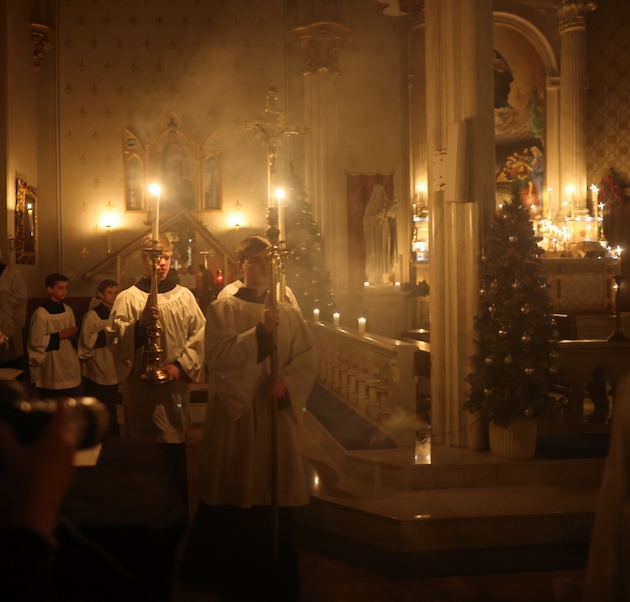
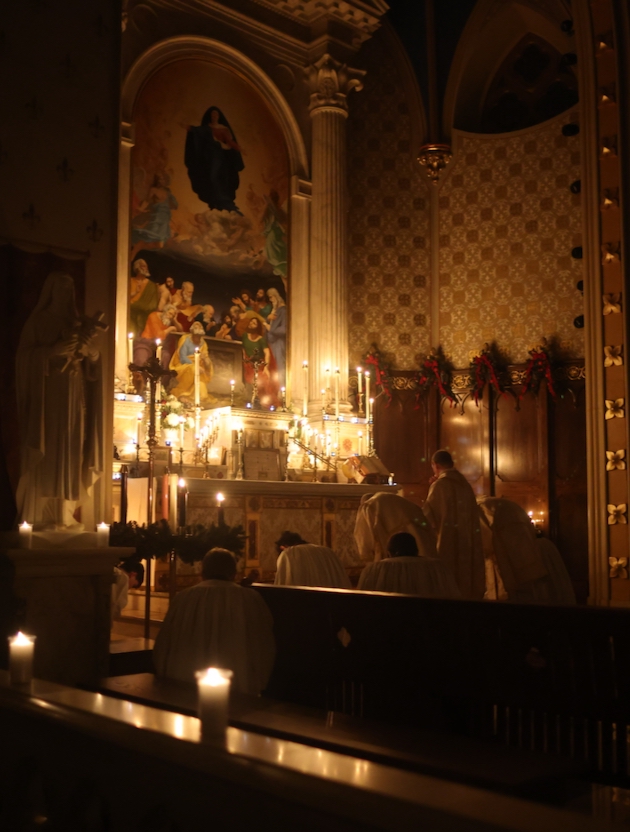
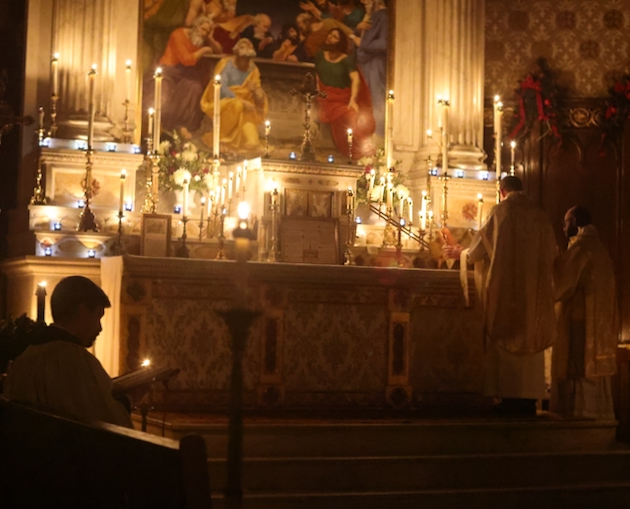
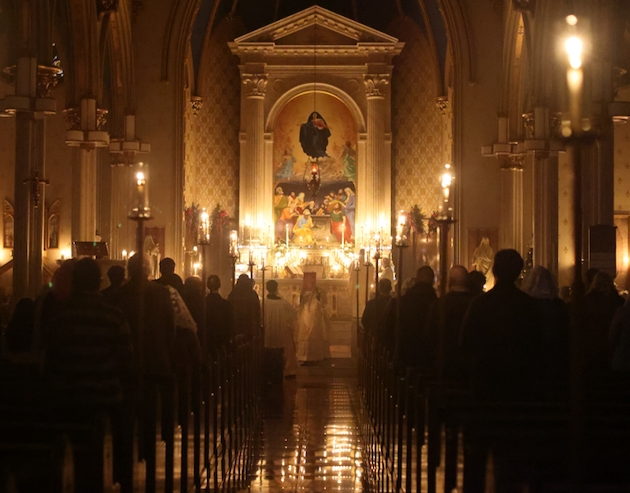
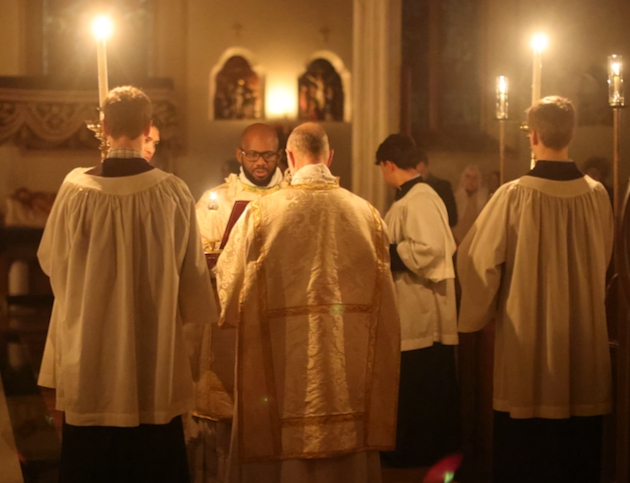
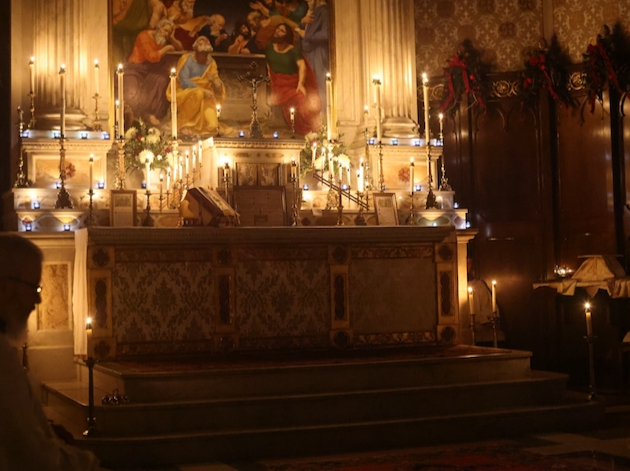
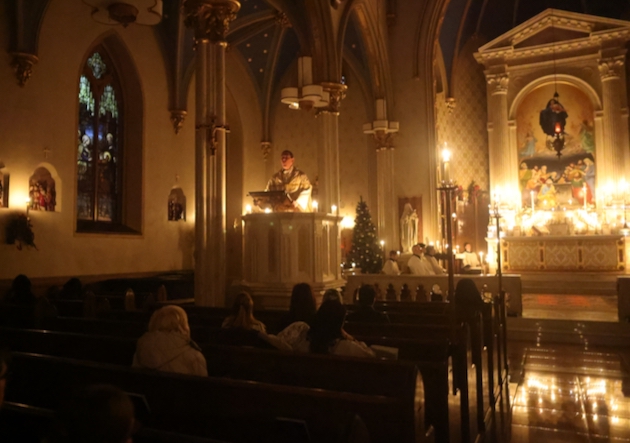
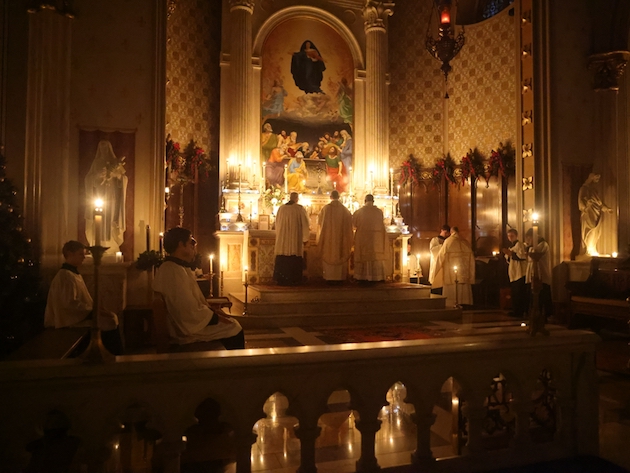
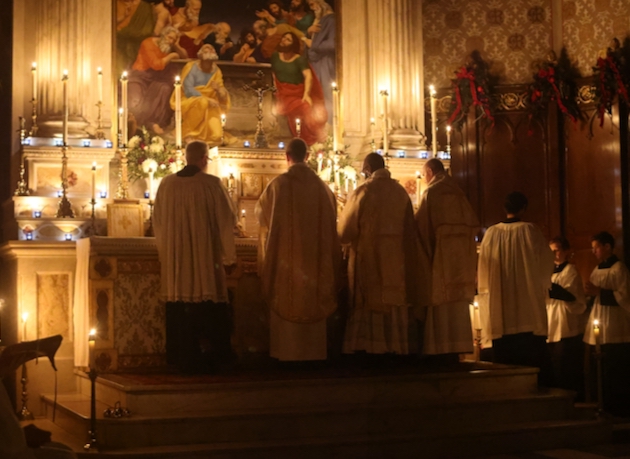
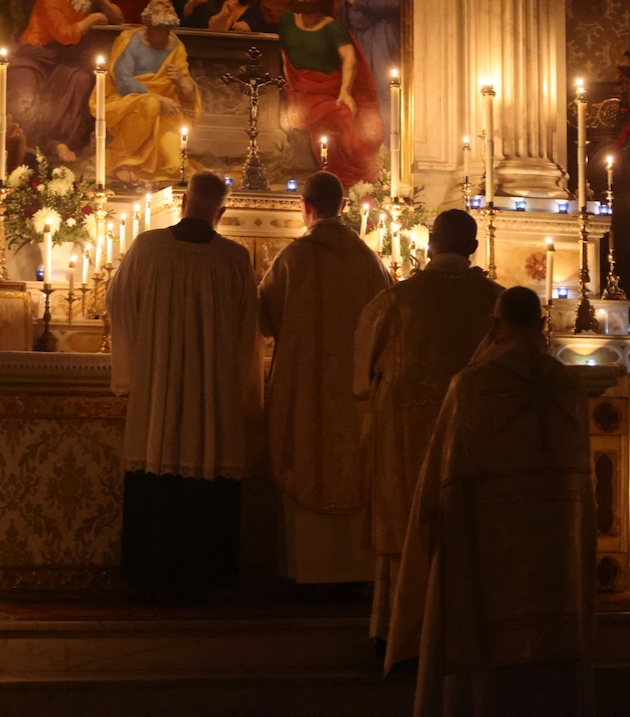
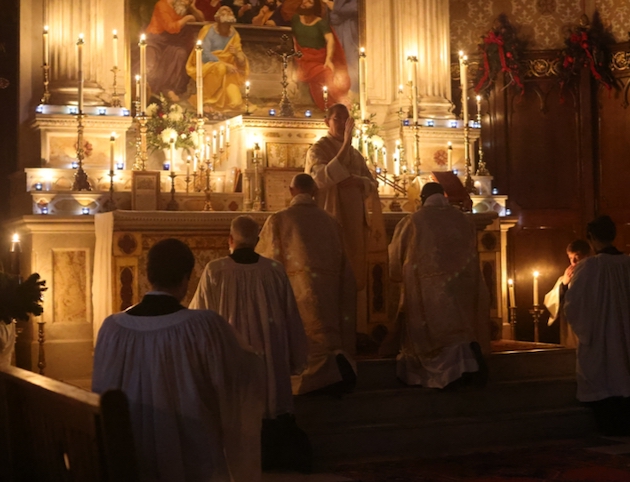
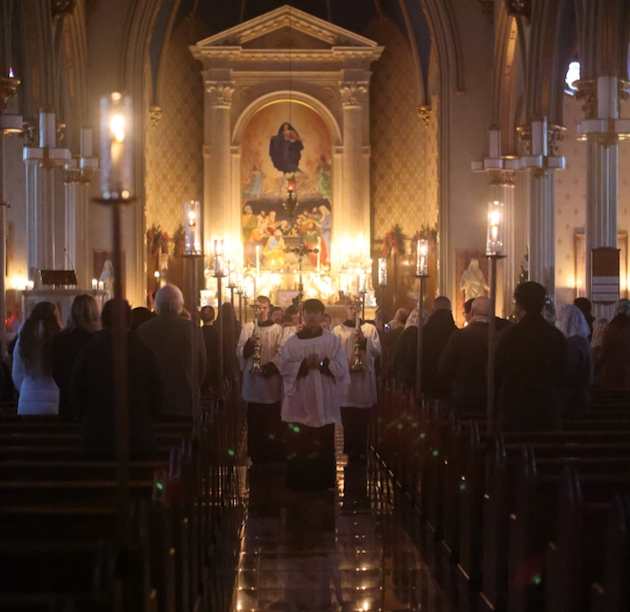
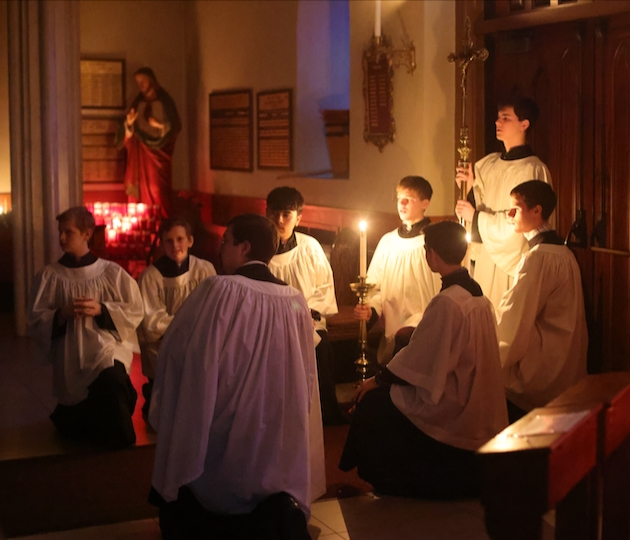
13
Dec
13
Dec
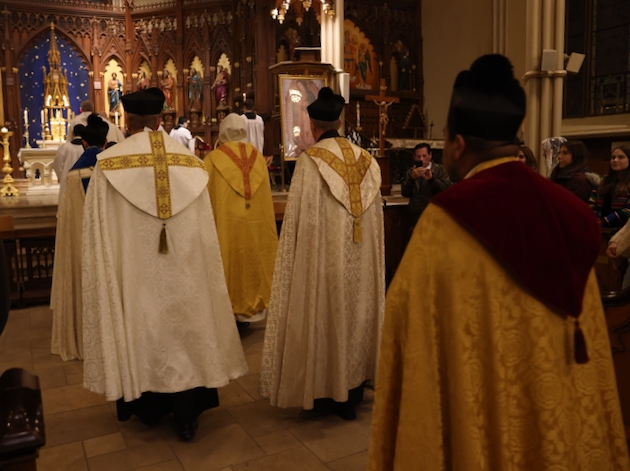
A splendid vespers with music primarily fron the Spanish and Mexican traditions. The Society of St. Hugh of Cluny was honored to co-sponsor the evening.
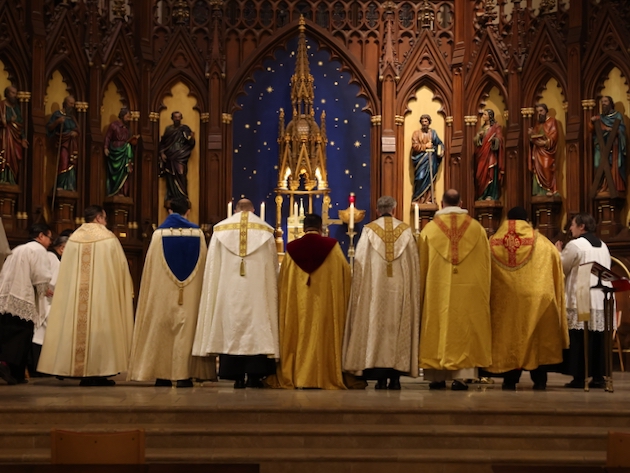
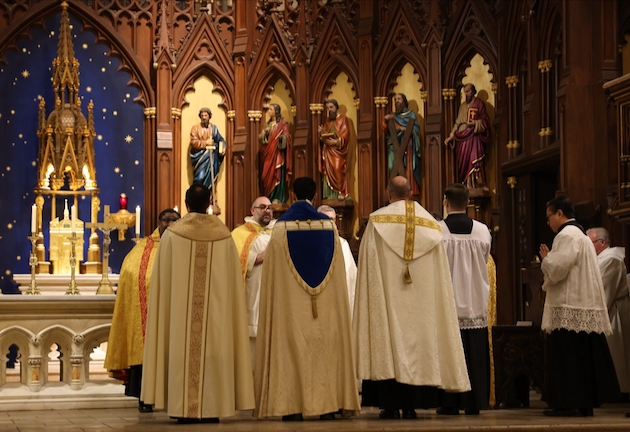
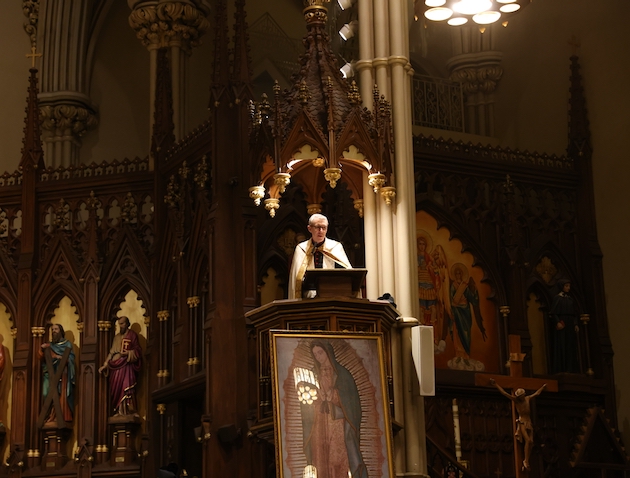
Rev. Daniel Ray, rector of the basilica, was the homilist.
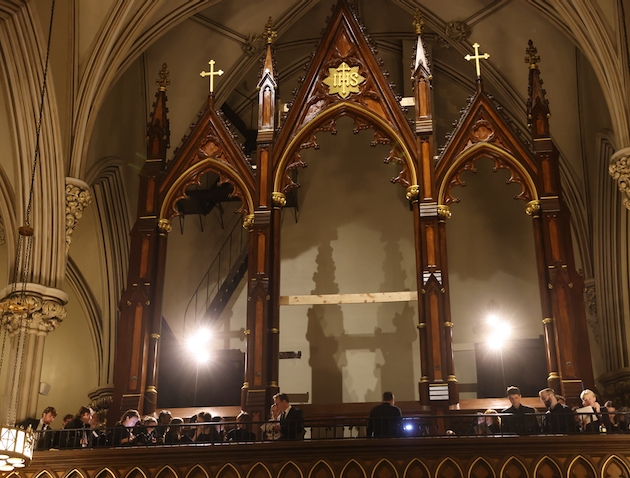
The magnificent 1868 Erben organ is still undergoing restoration. Jared Lamenzo, Director of Music of the Basilica, was the evening’s Director of Music. The musical forces of the basilica were reinforced by the visiting choir of Sidney Sussex College, Cambridge(David Skinner, Director of Music).
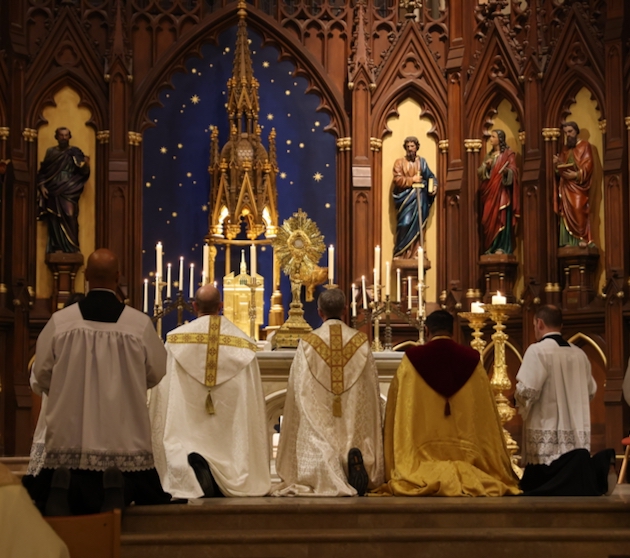
The evening concluded with Benediction.
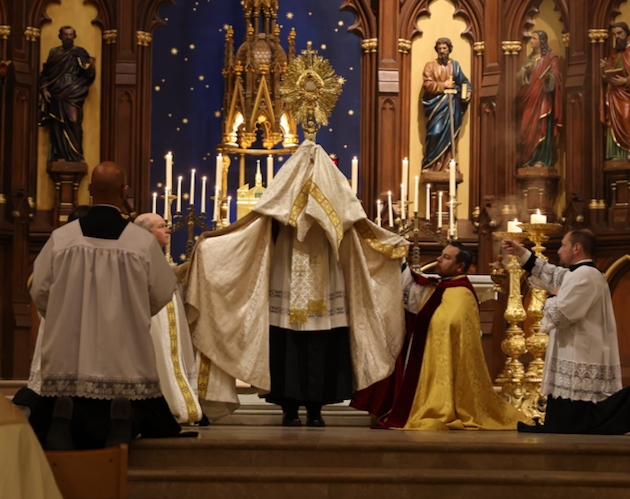
13
Dec
There will be a Missa Cantata at the Georgetown Oratory in Redding, CT, on Friday December 19 at 7 pm for the Ember Day. This Mass will be celebrated Coram Sanctissimo (in the presence of the exposed Sacrament) concluding with the Litany of the Most Sacred Heart and Benediction.
10
Dec
8
Dec
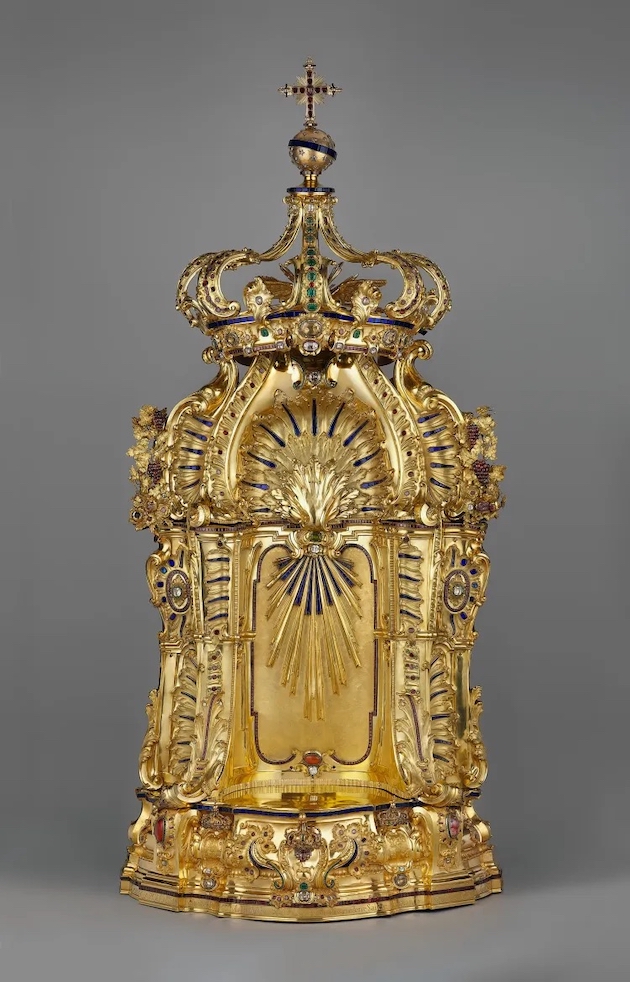
(Above) Antonio de Laurentiis, Throne of Eucharistic Exposition, 1754 (Gift of Kingdom of Naples). (Terra Sancta Museum, Jerusalem) © The Frick Collection
To the Holy Sepulcher: Treasures from the Terra Sancta Museum
Exhibition at the Frick Collection in New York (till January 5, 2026)
The Frick Collection now is showing a very special exhibition of liturgical objects from the Church of the Holy Sepulcher in Jerusalem. These treasures will be displayed in the Terra Sancta Museum in Jerusalem once it is completed.
After the final fall of the Holy Land to Islamic armies, the Western Catholic presence at the Church of the Holy Sepulcher was maintained by the Franciscan order – and still is today. Not that the relationship with other “faith communities” was necessarily easy. Over the centuries the ruling Muslim authorities oscillated between repression and tolerance. And, as described in the catalog, there were also violent clashes with the Greek Orthodox neighbors at this church. Yet whatever their religious feelings might be, the Ottoman Turkish authorities were constrained by the need to maintain good relations with the Western states, above all France. Of course, they also ere cognizant of the ongoing econmic benefits of the pilgrim trade.
Despite periodic vicissitudes, over the centuries the Franciscan mission accumulated a spectacular collection of liturgical art, donated by the leading Catholc powers. Ironically, unique vestments and liturgical objects have survived in this place so remote from Europe – because in Jerusalem they escaped the destruction and looting of the French revolutionaries and Napoleon’s armies.
The Frick hosted a similar exhibition in 2018-19 on the work of the 18thcentury Roman goldsmith Luigi Valadier. Indeed, Xavier F. Salomon, one of the co-organizers of the Holy Sepulcher exhibition, played a leading role in that exhibition as well. The Valadier exhibition also brought to our attention rare gold and silver works that survived in out-of-the-way churches and cathedrals in Southern Italy and Sicily, where they had escaped later post-1789 French depredations.
To the Holy Sepulcher is a remarkable and overwhelming show. There are gigantic silver candelabra, antependia and “thrones” for the display of a monstrance. There are of course chalices, monstrances, patens, croziers, sanctuary lamps and other liturgical apparatus. Magnificent sets of vestments in gold and scarlet can be seen. All of this was not “treasure” to be hoarded or put on display but was dedicated to actual liturgical use. Indeed, some of the vestments were refurbished later to preserve them for ongoing use.
The objects in the exhibition generally date from 1560 to around 1780. The artistic styles represented range from the later renaissance to baroque, rococo and early classicism. All of the powers of the Catholic world as it existed during and after the Counter-Reformation are represented: Spain, the Kingdom of Naples (perhaps the main donor state), France and Portugal but also the republics of Genoa and Venice. Given my own interests, I would single out the gifts from the Holy Roman Empire. Emperor Charles VI and Empress Maria Theresa are named donors of works created in Southern Germany and Austria.
It is a truly amazing reminder of how Christendom had survived into the 18th century and how the Catholic monarchs and republics thought it an honor to create magnificent objects for the Catholic liturgy in such a special place as Jerusalem. There was no question here of separation between church and state!
Now all of this art was destined for the celebration of the traditional liturgy. Indeed, the catalog features an essay by Jacques-Charles Gaffiot, one of the organizers of the exhibition, specifically discussing the Mass and the practical and symbolic role of the exhibits in liturgical celebrations. 1)
This exhibition leaves us with more solemn and melancholy thoughts. We encounter the glory of the Catholic liturgy as it existed in the last years of Christendom. But hasn’t the Church of today turned its back on the liturgy that gave rise to these objects? For these magnificent works the Church has often substituted vessels of glass and pottery. Then we must consider the current political situation. These liturgical objects and the Terra Sancta Museum in which they will be housed remind us of the perilous state of the Christian presence in the Holy Land. For the recent conflicts in the Near East are leading to the disappearance of the Christian minority in those countries.
For descriptions and photographs of the exhibits see To the Holy Sepulcher: Treasures from the Terra Sancta Museum (frick.org)
Postscript: It was my first visit to the Frick collection after its recent reconstruction and expansion. I only had time, however, to view the Holy Sepulcher exhibition. Inside the exhibition space, the layout and viewing conditions were excellent. I regret to say, however, that as a whole the Frick Collection itself has become a less pleasant place to visit. It is crowded and confusing, with vistors formed into lines under the supervision of guards. I would add to the irritations the steep admission charge and restrictions on photography (fortunately I am a member and hadn’t brought a camera along). “Points of light,” to be fair, were several helpful staff. The Frick, which once was an oasis of calm and contemplation in the city, now has an atmosphere more like that of its neighbor up the street, the Metropolitan Museum of Art. But perhaps these problems were only of that day; I will return after the New Year to find out more.
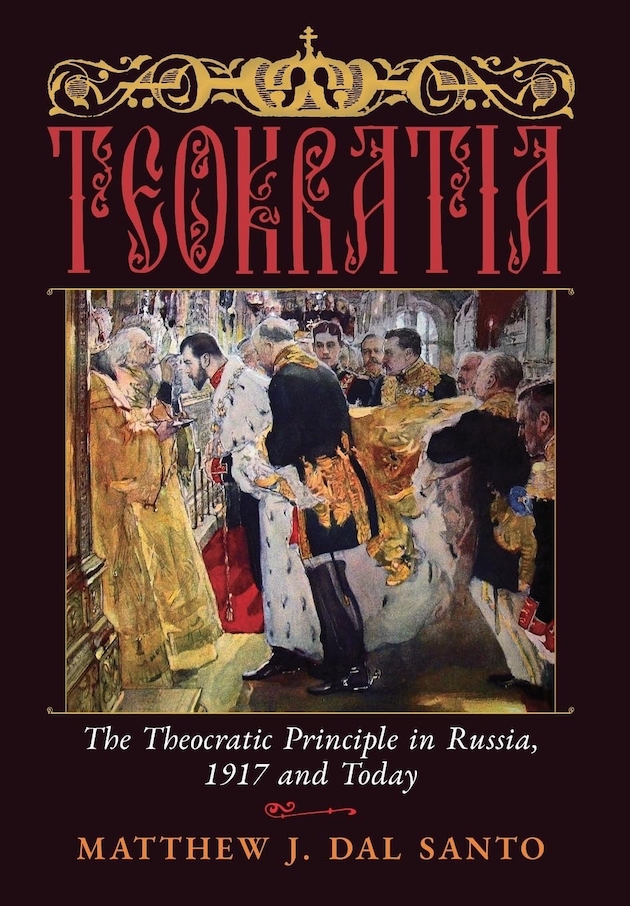
Teokratia: The Theocratic Principle in Russia, 1917 and Today
By Matthew J. Dal Santo
527 pages
2025 Angelico Press, Brooklyn, NY
Teokratia is a unique contribution to the Christian theory of the state and society. Right at the start I should say that “Teokratia’ – theocracy – in the East is not the same as its Western equivalent. In the West theocracy has connotations of rule by the clergy: the papacy in the High Middle Ages or the Calvinist clergy in Geneva or, later, colonial New England. In the East theocracy means, literally, the rule of God over the Church but also over the ruler and the state. The ruler derives his authority directly from God. Therefore, the ideal is harmony between these two powers – church and state – without the one dominating the other. You don’t have to be an expert in history to realize that this resembles strongly the relationship between the eastern Roman emperors and the Christian Church that developed after Constantine. Of course, as in ancient Constantinople, in Russia the state was by far the stronger partner.
Dal Santo structures his book around several distinct narratives. First, he sets forth Russian theological theory and attitudes towards the state as exemplified by the works of Sergei Bulgakov. Second, Teokratia is a history of the reign of the last tsar, Nicholas II, and attempts to understand and to a great extent justify his rule. Third, the author recounts his personal journey to Russia – and some adjacent areas that were in the Russian Empire in Nicholas’s time. Dal Santo follows the trail of Nicholas II and his family by visiting the places decisive in their life, such as the Crimea, where they lived, and Yekaterinburg where the Tsar and his family were killed. This journey is not just a travelogue of historical sights but also, in a series of discussions with ordinary Russians, a quest to gauge the relevance of “Teokratia” to Russia today. What do present-day Russians think of Nicholas II? And what is the role of the Orthodox Church in present day Russia?
Of course, starting with the Russian Orthodox Church Outside of Russia, Nicholas and his family have now been glorified (canonized). The author finds their icons in churches homes and chapels. And the imperial family is the subject of increasing devotion. Indeed, Dal Santo attributes the resurgent Christianity of Russia today to the presence and intercession of these saints. It is noteworthy that the patriarchate of Moscow, at least initially, distinguished the Romanov family from “martyrs” by calling them “passion-bearers,” a somewhat lesser title. That does not seem to make much of an impression upon the many devotees of the imperial family.
The author interprets this recovery of interest in the Romanovs as a development consequent to the collapse of the Soviet Union, which had repressed all inquiries into the life of Nicholas II. I’m in a position to offer a minor correction in that regard. For in 1973 upon my own visit to the Sts. Peter and Paul fortress in then-Leningrad I heard an ordinary Russian directly inquire of the official guide if Nicholas II was buried there. He was told that, no, he was not resting there among his ancestors.
A leading figure in this book is Sergei Bulgakov who, following the experience of a personal epiphany, turned from a secularist to a fervent believer in the Orthodox Church and in autocracy. Throughout the book the writings of Bulgakov provide commentary on the course of Nicholas’s reign. Although he became a fervent supporter of the principle of autocracy, Bulgakov was hardly uncritical regarding the political decisions of the Russian government.
Sergei Bulgakov was one of a group of thinkers and writers, associated with the publication of the collection of essays Vekhi in 1909, who fought for a recovery of the Russian spiritual tradition. They built on the legacy of Dostoevsky and Solovyov, among others. This group of intellectuals was, however, too late to breathe new intellectual and spiritual life into the Orthodox Church before disaster struck.
Throughout this book Dal Santo takes us though critical stages in the reign of Nicholas II. It’s less a political than a spiritual journey – often focusing on major liturgical celebrations. Teokratia reveals the sincere piety of Nicholas and his overwhelming sense of duty.
Of great interest to Catholic traditionalists should be the objective, liturgical nature of the Tsar’s religious life.
From a young age, participating in the liturgies of Church and observing the feasts and fasts of the liturgical year, Nicholas was captivated by the sensuous beauty of the chants, incense, candles, and icons, and only later was he instructed in the intellectual tenets of Orthodoxy. Indeed, having absorbed the elements of Orthodox family life at home with his parents, Nicholas seems to have approached Orthodoxy as a ritual world to be enjoyed, rather than as an intellectual proposition to be assented to or a moral code to be rigidly observed.(Teokratia, p.39)
In this “aliveness” to the Divine Liturgy, and their response to the Church’s sacramental and liturgical rites as something utterly real and transformative, Nicholas II and Bulgakov were one, and they were so often in isolation from their contemporaries, even Orthodox ones, who tended to downplay it as an empty, malleable ceremony. Indeed, if we have lingered so long here on the liturgy, it is because looking for the source of Nicholas’s own conception of Russia as a Teokratia, it is to the liturgy that we should turn. (Teokratia p.164)
The narrative culminates in a lengthy, horrifying but often moving description of the imprisonment, suffering and ultimately murder of Nicholas and his family in 1917-18.
Dal Santo defends Russia and Russia culture, now subject to such calumny and denigration by the dominant media, political, and academic forces of the West. In Western caricatures Russians today play a demonic role similar to that traditionally reserved to the Germans (or Confederate Southerners).Dal Santo, however, describes an entirely different picture – also in territories recovered by Russia, like the Crimea. Throughout the book there are entertaining accounts of meetings with ordinary Russians. Above all, Dal Santo demonstrates by many examples the religious recovery currently in progress everywhere in Russia.
Now at times Dal Santo takes his enthusiasm for Nicholas II and his defense of Russian history and culture a bit too far. In the case of Nicholas, for example, a principled feeling of dependence upon God and the rejection of atheistic alternatives to rule by divine delegation do not necessarily translate into competent decision making in political affairs. Nicholas’s choice of ministers, generals and advisors was extremely mixed. If Nicholas wished to return to the spiritual foundations of Russia also in political matters, that policy was undermined by his continuing alliance with freemasonic France, the most overtly atheistic power at that time in Europe.
We cannot say that the actions of Nicholas in pursuing the war against Japan in 1904 and, even more so, entering the war in Western Europe in 1914 were anything but disastrous. Interestingly, the much-maligned Rasputin seems to have had a much clearer insight into the consequences of latter decision than did Nicholas and his government. I doubt that the occupation of Galicia by the Russian army in 1914-1915 was in all respects the triumphant popular progress Dal Santo describes. Nor do I think that many military historians would share Dal Santo’s opinion that in December 1916 the Russian army had finally reached a successful stage in its 2 1/2 years of war.
Above all, Nicholas seemed utterly unable to convey to his officials his spiritual vision for the Russian state and people. The ruling circles of Russia completely misunderstood their emperor. Later, in the case of many, this alienation hardened into contempt and even outright hatred.
The traditionalist Catholic writer Cristina Campo had, already in 1971, eloquently summarized the spiritual vision of Nicholas II as well as the tragic dilemma he lived through:
“In a celebrated photograph, the last emperor of Russia wore the costume of one of his holy ancestors [Tsar Alexei Mikhailovitsch of the 17th century]. The high symmetry of the ample sleeves of purple satin is mysteriously replicated on his breast by the golden wings of a two-headed eagle…. All this speaks more than many pages of the mystical audacity of this unhappy sovereign, the last purely Muscovite Tsar, who tried, without intellectual arms, without political genius, without the help of a single human being, to return the Enlightenment autocracy of the Romanovs of St. Petersburg to its Russian archetype of a pure religious destiny… Empires fall when the education of princes yields to bourgeois inertia with its obstinate superstitious ignorance of the spiritual roots of all rule.” 1)
Dal Santo outlines an understanding of the role of the state and of the church radically different from that which prevails in the West today. Teokratia is completely at odds not only with the modern regimes of the West, but also with the political theories, such as “sound laicity,” which, after Vatican II, the Catholic Church has adopted as its own dogma. For instance, what would Russell Hittinger of the Catholic University think of this book?– he has proclaimed “separation” (of church and state) as being the founding political principle of Christianity.
Teokratia makes clear the impossibility of establishing a Western secularist regime in Russia. And that is a good thing! For, beyond the spirituality and political philosophy of Russia, Teokratia has much wider relevance. For Dal Santo describes the course of history as essentially a theological struggle. Drawing on the thought of Augusto Del Noce, Dal Santo Shows that the atheistic principles manifested in the Russian revolution have actually been more completely realized in the modern secular West. Moreover, since the West’s “victory” in 1989-91, the logic of revolutionary secularization has been ever more widely extended (Teokratia at pp. 21-22). For example, the revolutionary movement in the West has led to the total loss of symbols, destroying man’s ability to perceive reality – including political reality. In the East, however, symbols (like the icons!) and symbolic theology are indispensable in Orthodoxy. The above-mentioned Cristina Campo would have acknowledged the similarity of these thoughts to her own! But we are going too far afield. I do need to end my discussion of the remarkably rich book – I leave the rest to be discovered by the reader.
7
Dec
Monday, Dec. 8 is the Feast of the Immaculate Conception of the Blessed Virgin Mary. The following churches will offer Traditional Masses.
Connecticut
St Mary Chuch, Norwalk, 8 am Low Mass; 7 pm Solemn Mass
Georgetown Oratory of the Sacred Heart, Redding, 6 pm Missa Cantata followed by a tree-lighting
Sts. Cyril and Methodius Oratory, Bridegport, CT, 7:45 am Low Masss; 6 pm High Mass (“Missa O Soberana luz” – Felipe de Magalhães). Also on Sunday, Dec. 7: 6:00 p.m. – Solemn Choral Vespers and Benediction (First Vespers of the feast)
St. Patrick Oratory, Waterbury, 12 pm Low Mass; 6 pm High Mass
St. Martha Church, Enfield, 7 pm
New York
Holy Innocents Church, New York, NY, Low Mass 8 am; High Mass 6 pm
Our Lady of Mount Carmel, New York, NY, 7 am, 7 pm
St. Josaphat Oratory, Bayside, Queens, 7 am Low Mass; 7 pm High Mass
St. Rocco, Glen Cove, Long Island, 7 pm Missa Cantata
St. Matthew Church, Dix Hills, Long Island, 10:30 am
St. Paul the Apostle, Yonkers, 12 noon
Annunciation Church, Crestwood, NY, Lower church, 7 pm
New Jersey
Our Lady of Sorrows, Jersey City, 5 pm Missa Cantata
Our Lady of Victories, Harrington Park, 6 pm
Our Lady of Fatima, Pequannock, 7 am, 9am, 12 noon, 7 pm
St. Anthony Of Padua, West Orange, NJ, 7:30 am and 9 am Low Masses; 7 pm High Mass
Shrine Chapel of the Blessed Sacrament, Raritan, 7 pm
St. John the Baptist, Allentown, NJ, 7 pm Solemn Mass
3
Dec
1
Dec
28
Nov
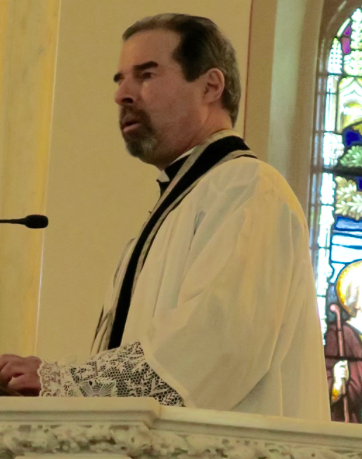
In your charity, we ask you to pray for Father Richard Munkelt, who celebrates the Sunday 4 pm Traditional Mass at Immaculate Conception Church in Sleepy Hollow, NY. Father Munkelt suffered a stroke last week.
He wrote this update today:
“I am still in the hospital because of a stroke, but I am about to be discharged to rehab. The stroke left me partially paralyzed on the right side, but I can move around with a walker. I expect a full recovery, please the Almighty, and to be with you all again in a few weeks. In the meantime, substitute priests will celebrate the Holy Mass at IC.”
